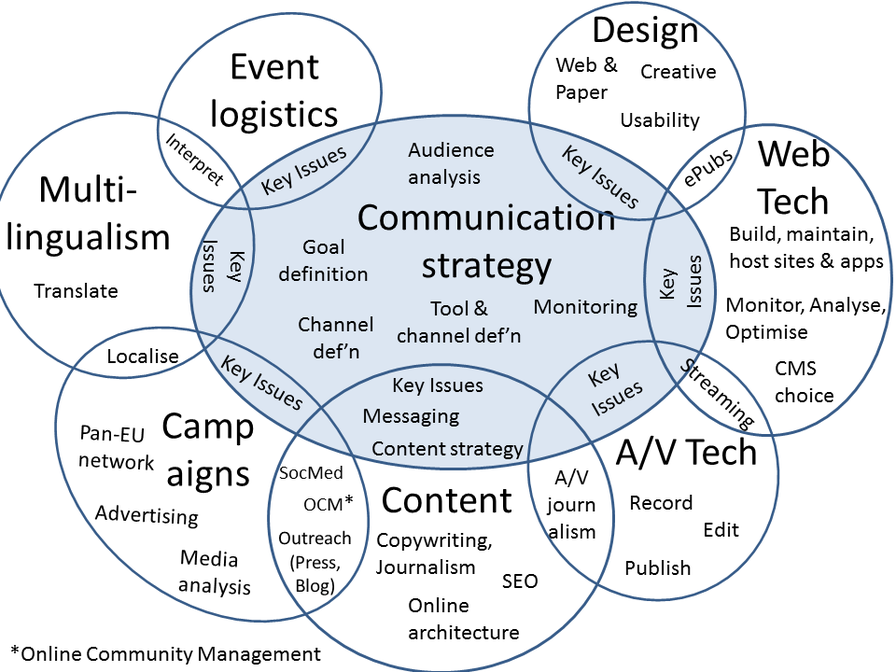How do you organise communications skills?

Imported from the Blogactiv.eu blogging platform, closed without warning in 2021. Links, images and embeds not guaranteed, and comments not displayed.
The number and diversity of communications skills needed to implement a communications strategy never stops growing. How are you organising them?
I've helped organise communications operations in four different organisations - three private sector agencies in EU Comms, and one EC Comms unit. Within each, human resources are each given a label - editorial, web, design - and lumped together in departments, teams or even (excitingly) 'competence centres' with the same label. And each turf department gets its warrior manager.
But how do you divide the continuum of communications work into discrete departments? After all, writing for the web is different to writing 'traditional' journalism, writing social media or writing copy for ads; designing posters is no preparation for web design, which increasingly needs programming skills anyway; and does anyone know where to put those social media experts?
Hierarchy or Circles?
Recently I came up with this pretty picture:
Each circle is a skillset, so let's call each circle a department to distinguish this from the circles you'll encounter in holacracy, which I encountered much later. Although it's a year or two old and so is probably already out of date, the main value for me was to identify the skills sitting in the overlaps between departments - e.g., social media and online community management sit in both Content and Campaigns, while A/V journalism sits in both Content and AV Tech.
Communications strategy has a central place because designing a communications strategy requires an understanding of the Key Issues about each of the other areas. These key issues therefore sit in overlap zones between CommStrat and each department - the only way to get that is to put CommStrat in the centre.
If this is your model, you have a problem
Now let's look at how most organisations arrange their communications resources:
Original link
This 'Fordian' hierarchical model - where workers are interchangeable drones on an assembly line - is about as useful to managing communications as it is suited to creating a work of art. Understand this:
- the skills you need will not fit into your tidy little boxes, no matter how you arrange them
- each individual on your team has a unique skillset and a unique career path
- locking them into a box will therefore stunt their growth, and their ability to deliver
- instead, treat people like individual human beings - you'll be able to develop them to their fullest potential, benefiting all involved.
Cracking the managerial problem
Someone needs to be responsible for ensuring that the organisation has the skills it requires, and the only person fit to judge the quality of a web programmer is another, more experienced web programmer. Taken together, this means that it has to be someone in the department responsible for developing that department's human resources (internal, external, partners), as well as juggling them between competing projects (resource coordination).
The problem is that judging quality, managing people and juggling resources between projects are three totally different things, and yet are usually all given to the one person: the department manager. Think about that for a second. You have a brilliant designer. To reward her, you make her Design Department Head. So now she spends all her time hiring and firing resources, finding freelancers, negotiating with partners, coaching people and juggling resources between braying project managers. And she never does any design work.
But she won't give the job to someone else because why should she report to someone her junior? So recognise that coordination, resource management and human management are three different roles. Maybe you should nominate a First Among Equals for each department, and rotate that position occasionally. Or leave the department manager with resource management, but hive off resource coordination to an assistant. Whatever. Just don't expect one person to do it all, and still deliver what s/he joined you for.
Any thoughts? Would love to hear it.
Related reading
More Stuff I Think
More Stuff tagged communications , organisation , management
See also: Communication Strategy , Digital Transformation , Change & Project Management , Communications Strategy , Business